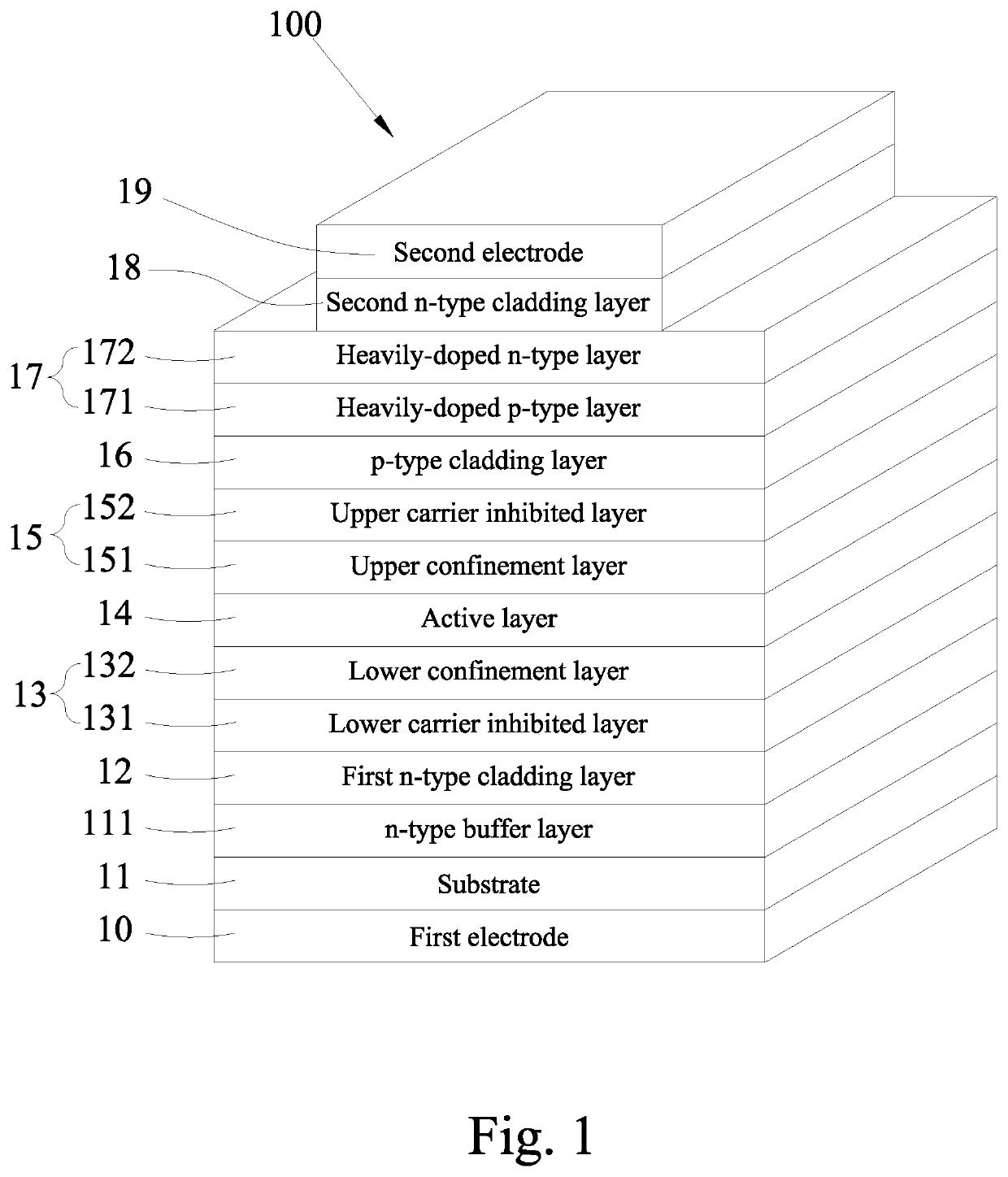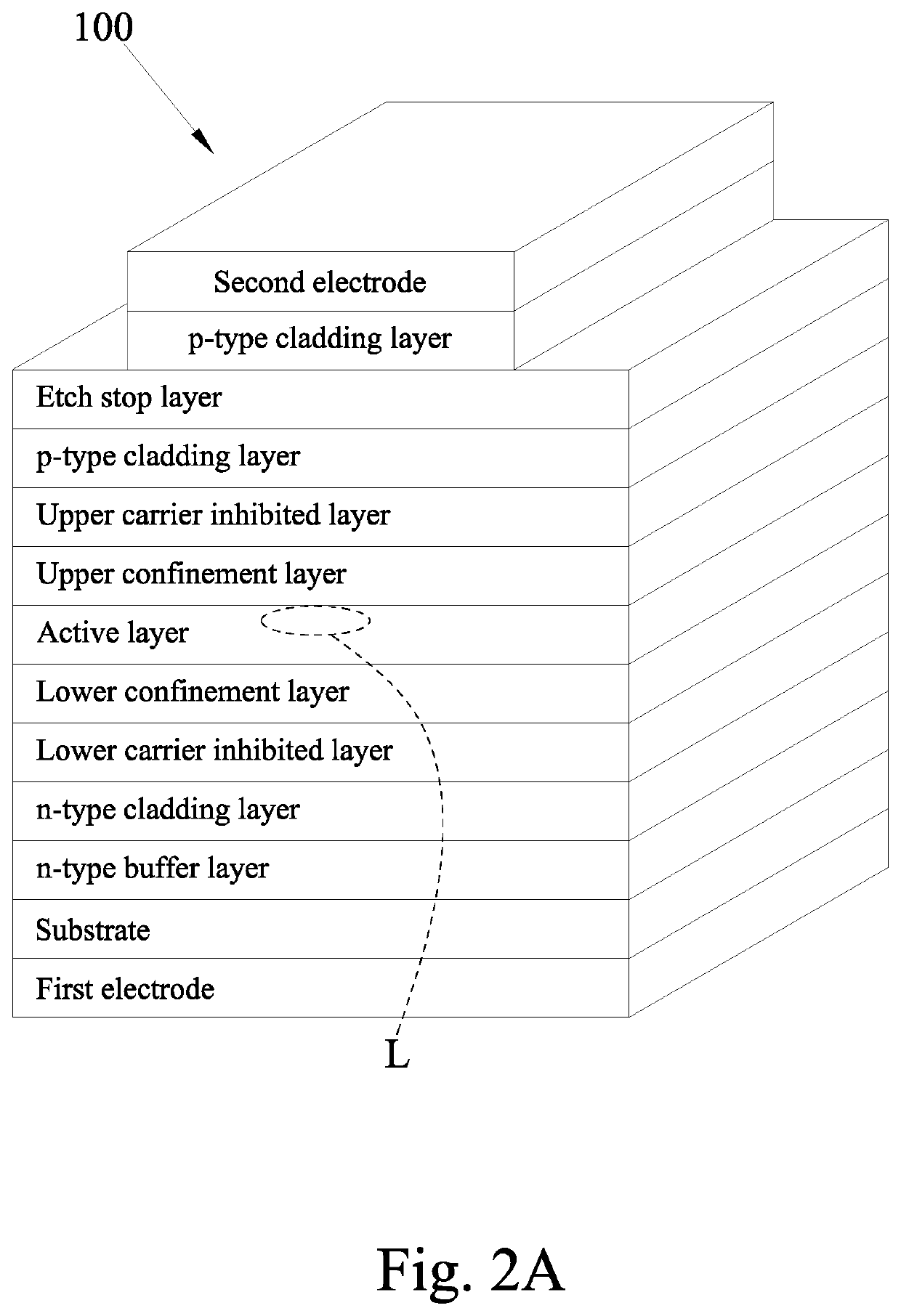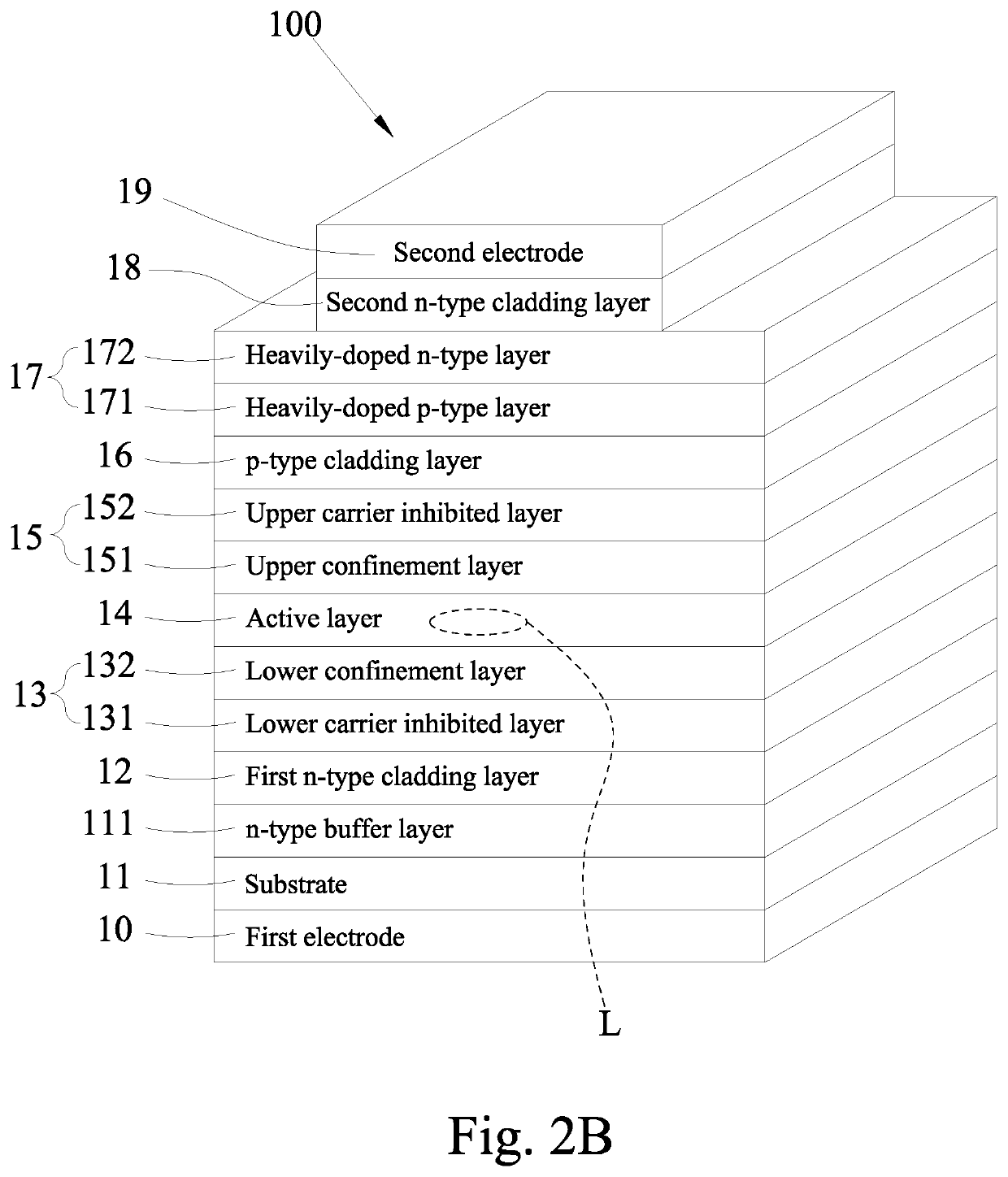Edge emitting laser device
a laser device and laser technology, applied in lasers, laser optical resonator construction, semiconductor lasers, etc., can solve the problems of higher material requirements, more complicated structure of laser devices, and more difficult design, so as to reduce the series resistance of edge emitting laser devices, reduce the resistance of p-type cladding layers, and increase the modal gain
- Summary
- Abstract
- Description
- Claims
- Application Information
AI Technical Summary
Benefits of technology
Problems solved by technology
Method used
Image
Examples
first embodiment
[0034]Table 2 lists the structural comparison of an EEL device (or FP laser device) in accordance with the present disclosure.
TABLE 2(First Embodiment)ThicknessDopant ContentLayerDescriptionMaterial(nm)Dopant(atoms / cm3)Type 1First electrodeInP200S1.0 × 1018~5.0 × 1018n10 2Substrate 11InP350000S1.0 × 1018~5.0 × 1018n 3n-type bufferInP500Si1.0 × 1018nlayer 111 4First n-typeInP100Si1.0 × 1018ncladding layer12 5Lower carrierAlInAs140Si5.0 × 1017ninhibited layer131 6LowerAlGaInAs50———confinementlayer 132 7Active layer 14AlGaInAs*Note——— 8UpperAlGaInAs50———confinementlayer 151 9Upper carrierAlInAs50———inhibitor layer15210p-type claddingInP50Zn5.0 × 1017player 1611Tunnel junctionInGaAsP15CGreater thanplayer 171.0 × 1019(heavily-dopedp-type layer171)Tunnel junctionInGaAsP15TeGreater thannlayer 171.0 × 1019(heavily-doped n-typelayer 172)12Second n-typeInP1500Si7.0 × 1017~1.5 × 1018ncladding layer1813SecondInGaAs200TeGreater thannelectrode 191.0 × 1019*Note:The thickness of the active layer c...
second embodiment
[0038]Table 4 lists the structural comparison of an EEL device (or DFB laser device) in accordance with the present disclosure.
TABLE 4(Second Embodiment)ThicknessDopant ContentLayerDescriptionMaterial(nm)Dopant(atoms / cm3)Type 1First electrodeInP200S1.0 × 1018~5.0 × 1018n10 2Substrate 11InP350000S1.0 × 1018~5.0 × 1018n 3n-type bufferInP500Si1.0 × 1018nlayer 111 4First n-typeInP100Si1.0 × 1018ncladding layer124-1Grating layer GInGaAsP35Si1.0 × 1018n4-2Spacer layer SInP150Si1.0 × 1018n 5Lower carrierAlInAs50Si5.0 × 1017ninhibited layer131 6LowerAlGaInAs50———confinementlayer 132 7Active layer 14AlGaInAs*Note——— 8LowerAlGaInAs50———confinementlayer 151 9Upper carrierAlInAs50———inhibited layer15210p-type claddingInP50Zn5.0 × 1017player 1611Tunnel junctionInGaAsP15CGreater thanplayer 171.0 × 1019(heavily-dopedp-type layer171)Tunnel junctionInGaAsP15TeGreater thannlayer 171.0 × 1019(heavily-dopedn-type layer172)12Second n-typeInP1500Si7.0 × 1017~1.5 × 1018ncladding layer1813SecondInGaAs200Te...
third embodiment
[0042]Table 6 lists the structural comparison of an EEL device (or DFB laser device) in accordance with the present disclosure.
TABLE 6(Third Embodiment)ThicknessDopant ContentLayerDescriptionMaterial(nm)Dopant(atoms / cm3)Type 1First electrode 10InP200S1.0 × 1018~5.0 × 1018n 2Substrate 11InP350000S1.0 × 1018~5.0 × 1018n 3n-type buffer layerInP500Si1.0 × 1018n111 4First n-typeInP100Si1.0 × 1018ncladding layer 12 5lower carrierAlInAs50Si5.0 × 1017ninhibited layer 131 6LowerAlGaInAs50———confinement layer132 7Active layer 14AlGaInAs*Note——— 8UpperAlGaInAs50———confinement layer151 9Upper carrierAlInAs50———inhibited layer 15210p-type claddingInP20Zn5.0 × 1017player 1611Tunnel junctionInGaAsP15CGreater thanplayer 171.0 × 1019(heavily-doped p-type layer 171)Tunnel junctionInGaAsP15TeGreater thannlayer 17 (heavily-1.0 × 1019doped n-type layer172)12Lower second n-InP25Si1.0 × 1018ntype claddinglayer 18112-1Grating layer GInGaAsP15Si1.0 × 1018n13Upper second n-InP1500Si7.0 × 1017~1.5 × 1018ntype...
PUM
| Property | Measurement | Unit |
|---|---|---|
| thickness | aaaaa | aaaaa |
| thickness | aaaaa | aaaaa |
| thickness | aaaaa | aaaaa |
Abstract
Description
Claims
Application Information
 Login to View More
Login to View More - R&D
- Intellectual Property
- Life Sciences
- Materials
- Tech Scout
- Unparalleled Data Quality
- Higher Quality Content
- 60% Fewer Hallucinations
Browse by: Latest US Patents, China's latest patents, Technical Efficacy Thesaurus, Application Domain, Technology Topic, Popular Technical Reports.
© 2025 PatSnap. All rights reserved.Legal|Privacy policy|Modern Slavery Act Transparency Statement|Sitemap|About US| Contact US: help@patsnap.com



